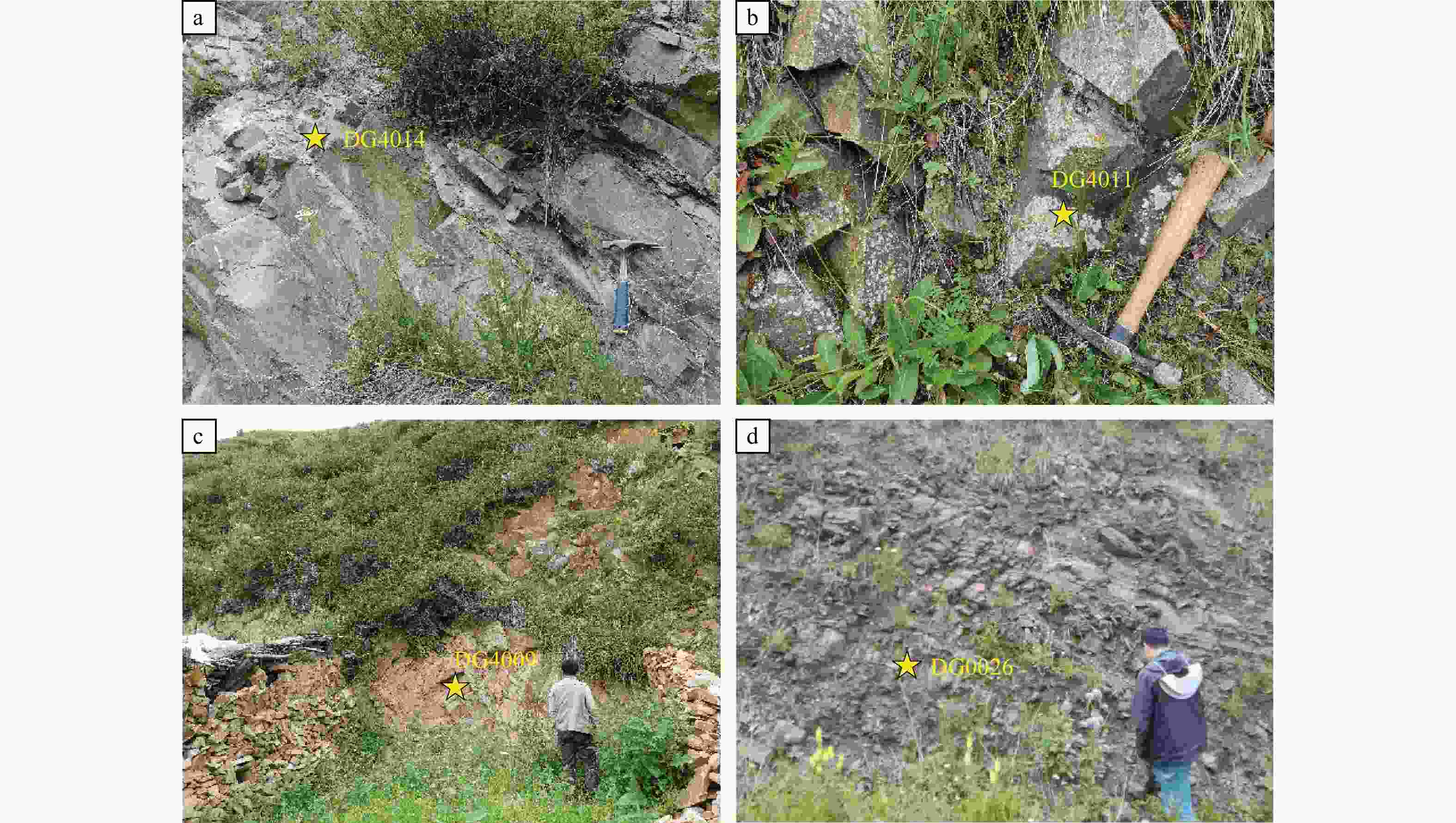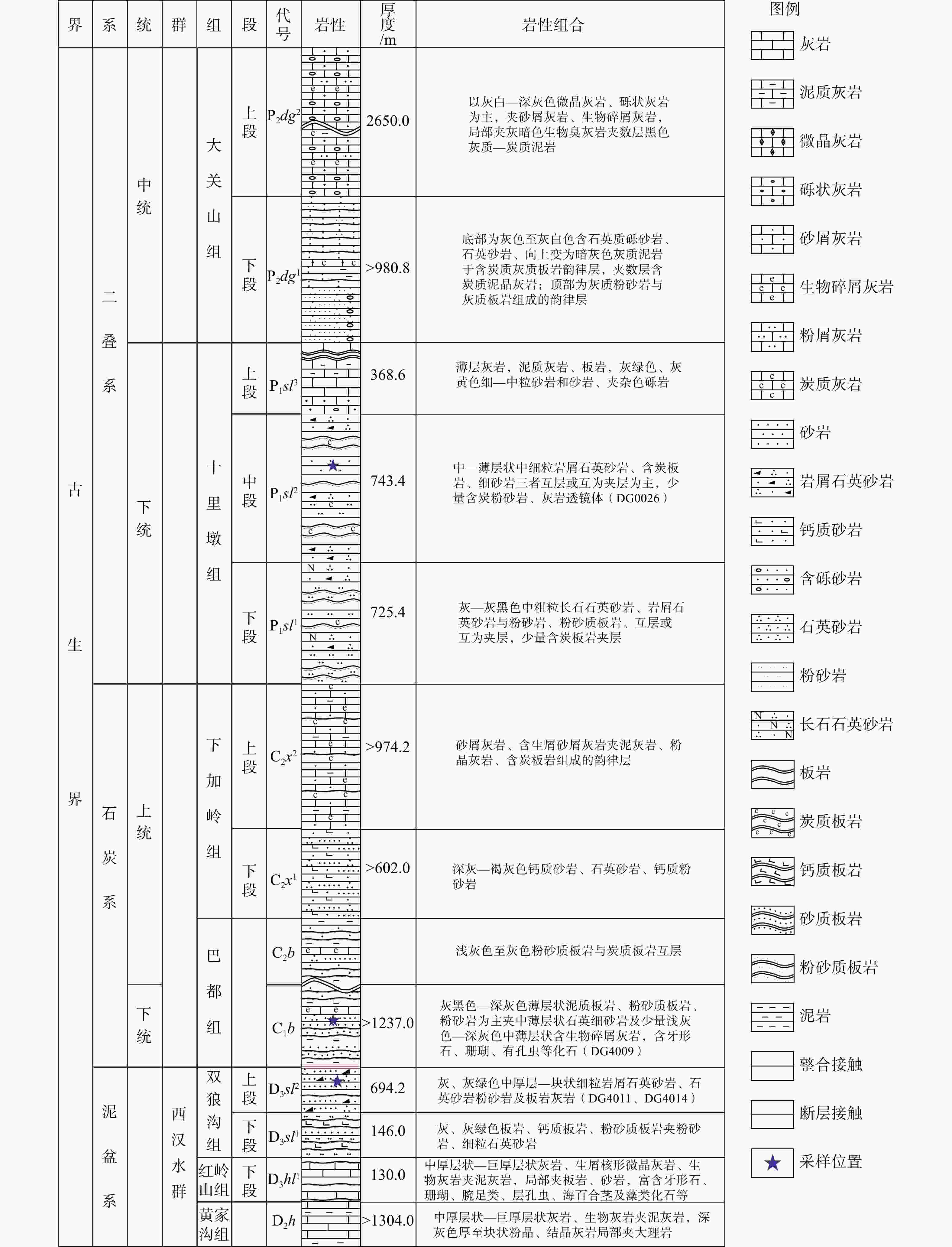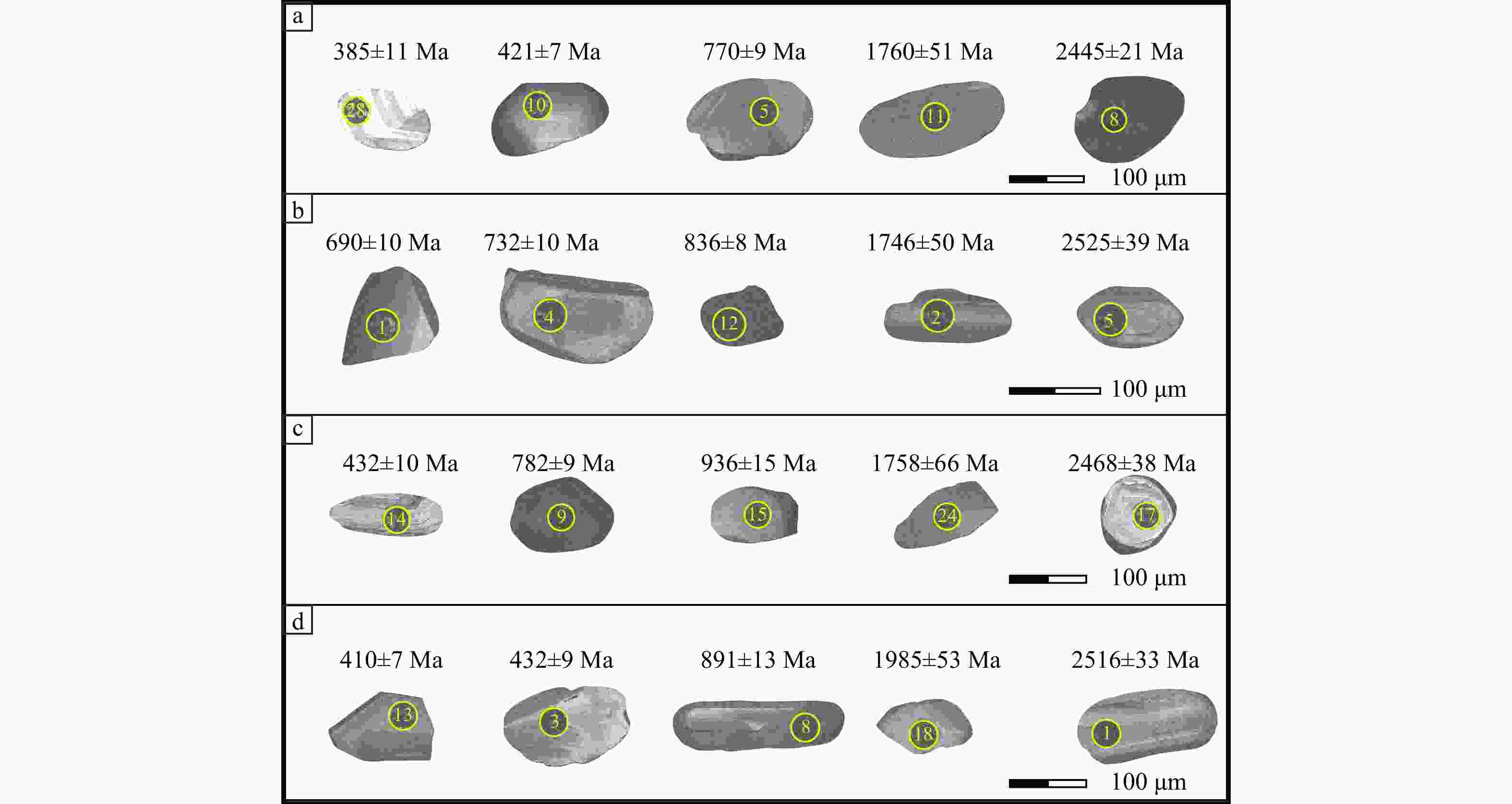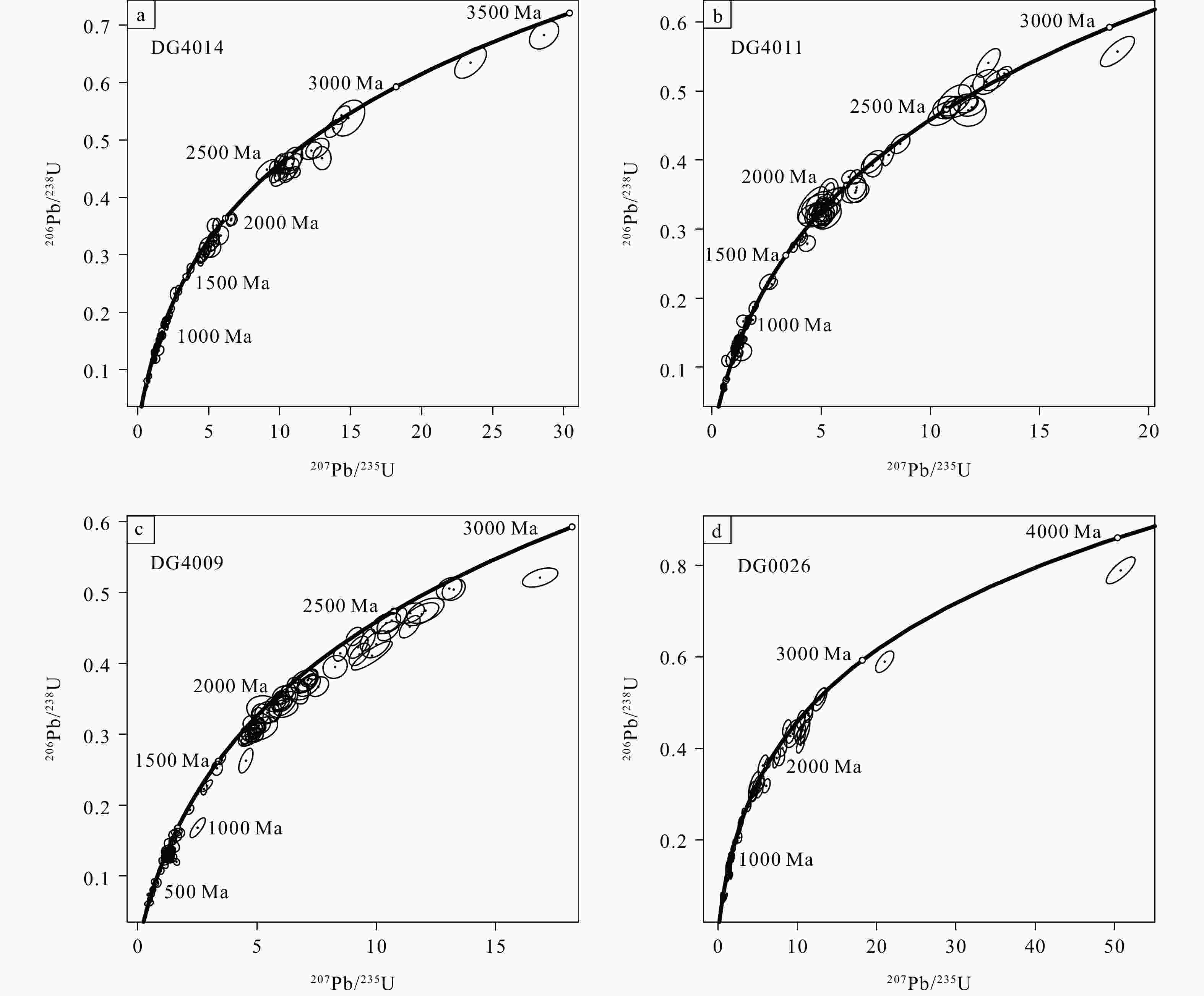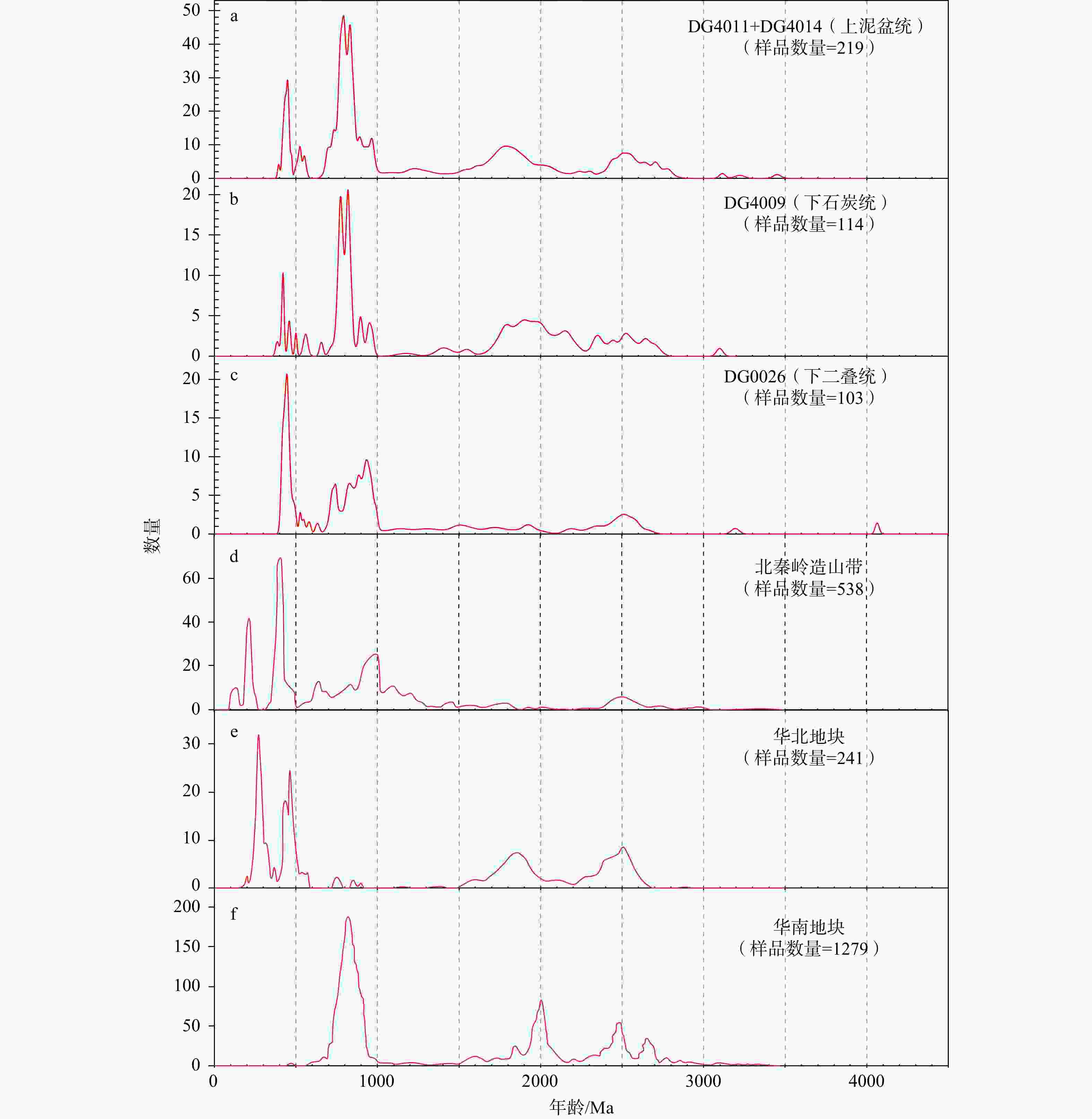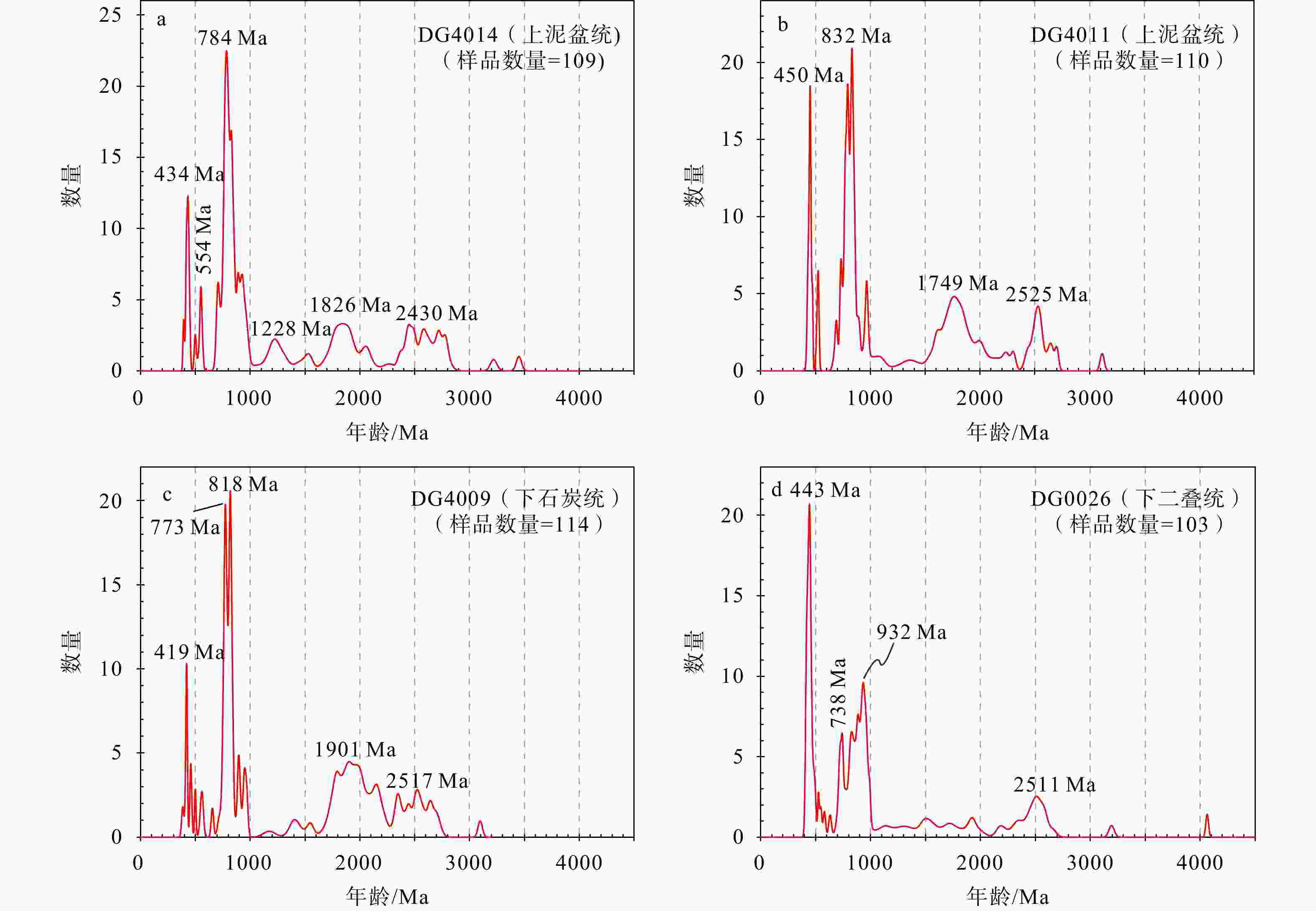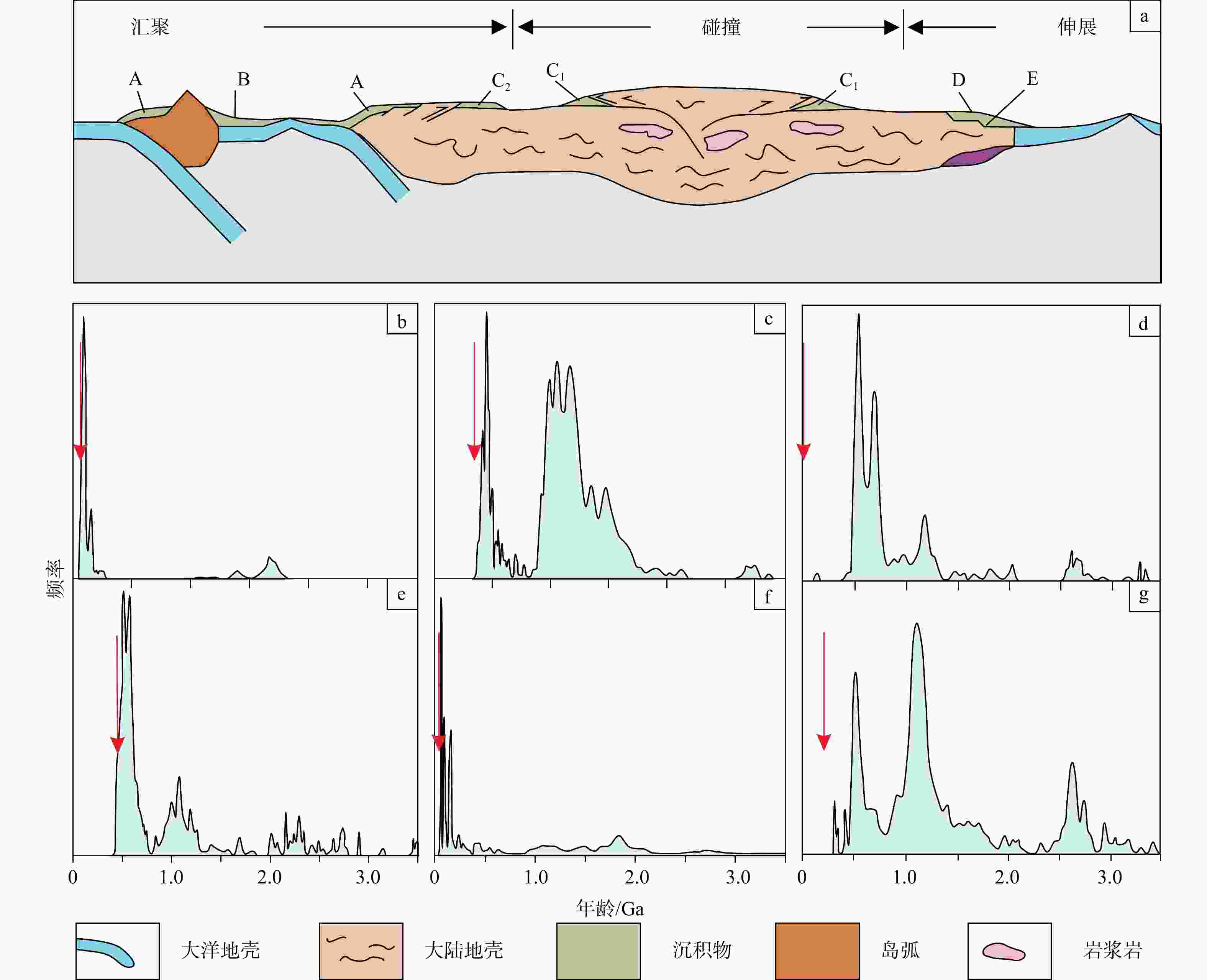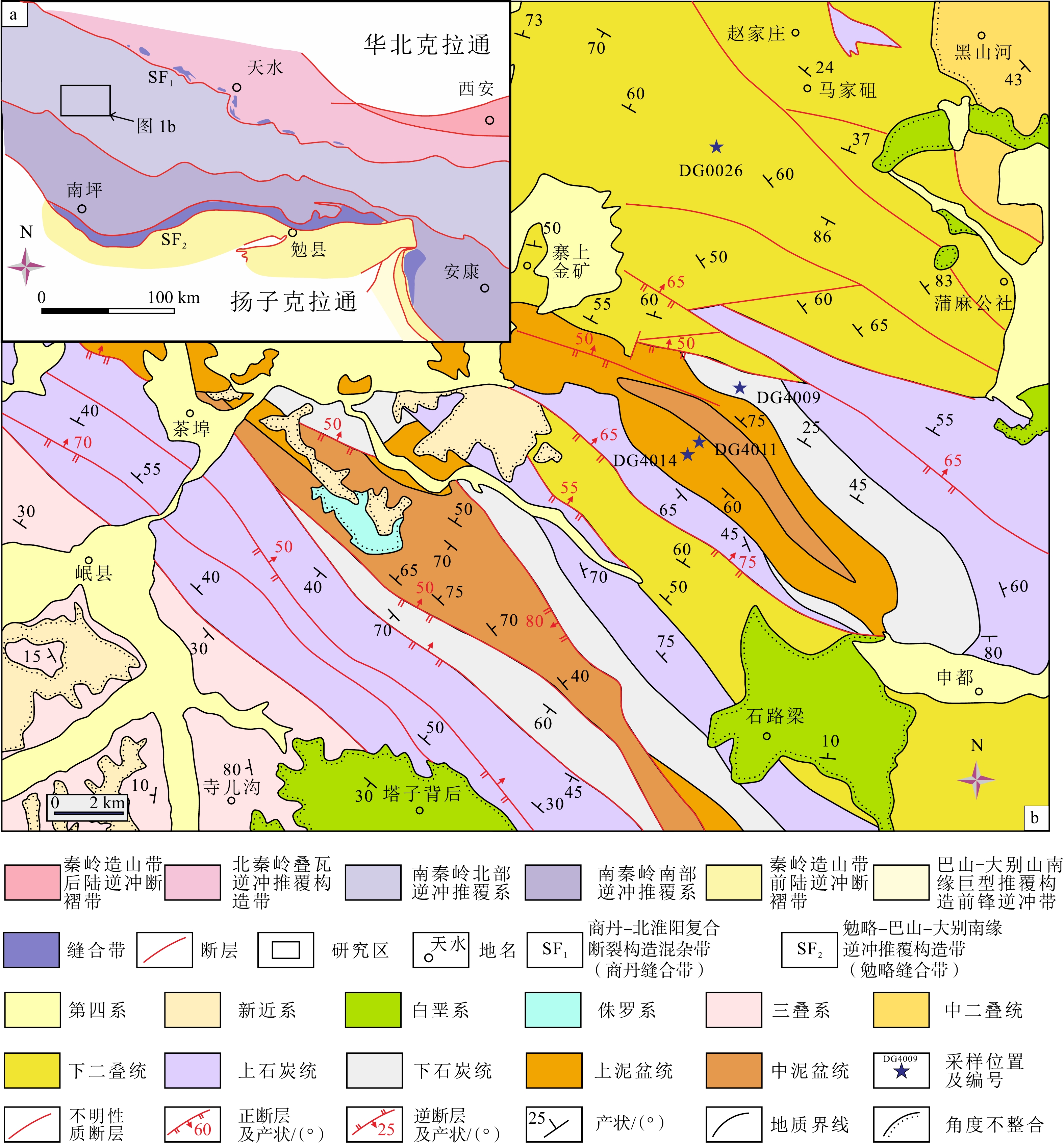Late Paleozoic tectonic evolution of the Qinling Orogenic Belt: Constraints and insights from detrital zircon U–Pb geochronology in the Western Qinling
-
摘要: 秦岭造山带位于扬子与华北克拉通之间,经历了古生代-早中生代多阶段演化过程,完整记录了扬子−华北克拉通的碰撞造山历史。在物源、岩石地球化学、岩浆活动及大地构造等领域已积累大量研究成果,但秦岭造山带早古生代构造格局及晚古生代洋盆演化等关键问题仍存争议,主要有以下观点:商丹洋的闭合时间为早志留世、石炭纪与印支期;勉略洋初始俯冲时间为早石炭世、晚二叠世、晚二叠世末以及晚于早三叠世。岷县寨上地区位于西秦岭造山带,古生代地层广泛发育,是研究秦岭造山带构造演化历史的重要窗口。对该区出露的泥盆系、石炭系和二叠系开展系统采样,依次实施锆石单矿物分选、制靶、抛光及阴极发光(CL)图像拍摄,利用 LA-ICP-MS 进行锆石 U-Pb 年代学分析。通过分析实验结果,对西秦岭岷县寨上地区出露的泥盆系、石炭系和二叠系开展碎屑锆石 LA-ICP-MS U-Pb 年代学研究,以限定秦岭造山带古生代构造演化历史及沉积过程。碎屑锆石U-Pb年代学研究结果表明,岷县寨上地区西汉水群双狼沟组和巴都组具有相似的碎屑锆石年龄组成。泥盆系西汉水群双狼沟组碎屑锆石的主要年龄峰值为794 Ma,最年轻年龄峰值为448 Ma,以新元古代年龄组(746~880 Ma)为特征。下石炭统巴都组碎屑锆石主要年龄峰值为818 Ma,最年轻年龄峰值为390 Ma,以新元古代年龄组(750~901 Ma)为特征。下二叠统十里墩组中段碎屑锆石主要年龄峰值为443 Ma,最年轻年龄峰值为443 Ma,以早古生代年龄组(409~464 Ma)为特征。通过对比泥盆系、石炭系、二叠系碎屑锆石U-Pb年龄相对概率分布曲线及碎屑锆石年龄峰与构造背景关系图(对比对象包括北秦岭造山带、华北克拉通和扬子克拉通)发现:寨上地区泥盆系双狼沟组与石炭系巴都组具有一致的碎屑物质来源,其物源主要来自扬子克拉通,其次来自北秦岭造山带,且构造背景均属于裂谷盆地。而二叠系十里墩组中段碎屑物质则主要来源于北秦岭造山带,其构造背景为弧后盆地。结合研究结果以及秦岭造山带、华北克拉通、扬子克拉通、商丹洋和勉略洋的相对位置综合判断可知,岷县寨上地区在晚泥盆世—早石炭世期间处于裂谷盆地环境,至早二叠世转变为弧后盆地,这标志着勉略洋在此期间完成了由大洋扩张到大洋俯冲消亡的转换。此外,还限定勉略洋打开时间晚于早石炭世,商丹洋闭合时间早于晚泥盆世。这为秦岭造山带构造演化过程以及商丹洋的闭合时间和勉略洋初始俯冲时间提供了新的证据和年代学约束,有助于帮助恢复构建秦岭造山带的构造演化过程。
-
关键词:
- 碎屑锆石 /
- LA-ICP-MS U-Pb年代学 /
- 物质来源 /
- 沉积环境 /
- 西秦岭造山带
Abstract:Objective The Qinling Orogenic Belt, positioned between the Yangtze and North China cratons, has undergone a multi-stage evolution from the Paleozoic to the Early Mesozoic, fully documenting the collisional orogenic history between both cratons. Substantial research achievements have been accumulated in fields such as provenance, lithogeochemistry, magmatic activity, and tectonics. However, key issues regarding the Early Paleozoic tectonic framework and Late Paleozoic ocean basin evolution of the Qinling Orogenic Belt remain controversial, primarily including the following aspects: The Shangdan Ocean may have closed during the Early Silurian, Carboniferous, or Indosinian periods; the subduction of the Mianlue Ocean may have initiated in the Early Carboniferous, Late Permian, end of the Late Permian, or later than the Early Triassic. The Zhaishang area in Minxian County, located within the Western Qinling Orogenic Belt, shows extensive Paleozoic strata and serves as a critical window for studying the tectonic evolution history of the Qinling Orogenic Belt. Methods Systematic sampling was conducted on the exposed Devonian, Carboniferous, and Permian strata in this area. The procedures included zircon single-mineral separation, target preparation, polishing, and cathodoluminescence (CL) imaging, followed by zircon U–Pb isotope analysis using LA–ICP–MS (Laser Ablation Inductively Coupled Plasma Mass Spectrometry). Based on these experimental results, detrital zircon U–Pb chronology was performed for the Devonian, Carboniferous, and Permian strata exposed in the Zhaishang area of Minxian County, Western Qinling, to constrain the Paleozoic tectonic evolution history and sedimentary processes of the Qinling Orogenic Belt. Results Results of detrital zircon U-Pb chronology show that the Shuanglanggou Formation of the Xihan Shui Group and the Badu Formation in the Zhaishang area of Minxian County exhibit similar detrital zircon age compositions. Detrital zircons from the Shuanglanggou Formation (Devonian Xihanshui Group) are characterized by the dominant age peak at 794 Ma, belonging to a Neoproterozoic age group (880~746 Ma), and the youngest age peak at 448 Ma. Detrital zircons from the Lower Carboniferous Badu Formation display Neoproterozoic age groups (901~750 Ma), the dominant age peak at 818 Ma, and the youngest age peak at 390 Ma. Detrital zircons from the middle member of the Lower Permian Shilidun Formation exhibit the dominant and likewise youngest age peak at 443 Ma, belonging to an Early Paleozoic age group (464~409 Ma). Conclusion Through comparing the relative probability distribution curves of detrital zircon U–Pb ages of the Devonian, Carboniferous, and Permian strata, as well as the correlation diagrams between detrital zircon age peaks and tectonic settings (including the northern Qinling Orogenic Belt, North China Craton, and Yangtze Craton as comparison targets), it is revealed that: The Devonian Shuanglanggou Formation and the Carboniferous Badu Formation in the Zhaishang area share a consistent detrital provenance, primarily the Yangtze Craton, followed by the northern Qinling Orogenic Belt; both tectonic settings are classified as rift basins. The detrital materials of the middle member of the Permian Shilidun Formation stem predominantly from the northern Qinling Orogenic Belt and correspond to a back-arc basin tectonic setting. By integrating the research results with the relative positions of the Qinling Orogenic Belt, the North China Craton, the Yangtze Craton, the Shangdan Ocean, and the Mianlue Ocean, it is concluded that the Zhaishang area in Minxian County was in a rift basin environment from the Late Devonian to the Early Carboniferous, and transitioned to a back-arc basin in the Early Permian. This transition marks the completion of the Mianlue Ocean’s evolution from oceanic expansion to subduction and demise. Additionally, the study constrains that: The Mianlue Ocean opened after the Early Carboniferous; the Shangdan Ocean closed before the Late Devonian. [ Significance ] This study provides new evidence and chronological constraints for the tectonic evolution of the Qinling Orogenic Belt, as well as the closure time of the Shangdan Ocean and the initial subduction time of the Mianlue Ocean, helping to reconstruct and restore the tectonic evolution process of the Qinling Orogenic Belt. -
图 1 西秦岭造山带地质简图及岷县寨上地区区域地质简图及采样位置图
a—西秦岭造山带地质简图(据张国伟等,2019修改);b—岷县寨上地区区域地质简图及采样位置图
Figure 1. Geological sketch map of the western Qinling Orogenic Belt and regional geological map of the Zhaishang area in Min County with sampling locations (slightly modified from Zhang et al., 2019).
(a) Geological sketch map of the western Qinling Orogenic Belt; (b) Regional geological map of the Zhaishang area in Min County with sampling locations
图 2 岷县寨上地区典型沉积岩露头及采样位置照片
a—样品DG4014采样位置;b—样品DG4011采样位置;c—样品DG4009采样位置;d—样品DG0026采样位置
Figure 2. Outcrop photographs of typical sedimentary rocks and sample locations, Zhaishang Area, Min County
(a) Sampling location of Sample DG4014; (b) Sampling location of Sample DG4011; (c) Sampling location of Sample DG4009; (d) Sampling location of Sample DG0026
图 4 岷县寨上地区沉积岩中碎屑锆石的CL图像及年龄值
a—样品DG4009代表性锆石CL图像及年龄;b—样品DG4011代表性锆石CL图像及年龄;c—样品DG4014代表性锆石CL图像及年龄;d—样品DG0026代表性锆石CL图像及年龄
Figure 4. CL images and age values of detrital zircons from sedimentary rocks in the Zhaishang area, Min County
(a) Representative zircon CL images and age values of Sample DG4009; (b) Representative zircon CL images and age values of Sample DG4011; (c) Representative zircon CL images and age values of Sample DG4014; (d) Representative zircon CL images and age values of Sample DG0026
图 5 岷县寨上地区沉积岩中碎屑锆石的U-Pb年龄谐和图
a—样品DG4014U-Pb年龄谐和图;b—样品DG4011U-Pb年龄谐和图;c—样品DG4009U-Pb年龄谐和图;d—样品DG0026U-Pb年龄谐和图
Figure 5. U–Pb concordia diagrams of detrital zircons from sedimentary rocks in the Zhaishang area, Min County
(a) U–Pb concordia diagram for Sample DG4014; (b) U–Pb concordia diagram for Sample DG4011; (c) U–Pb concordia diagram for Sample DG4009; (d) U–Pb concordia diagram for Sample DG0026
图 7 岷县寨上地区及其邻区U-Pb年龄相对概率分布图
a—样品DG4014和样品DG4011综合年龄相对概率分布图;b—样品DG4009U-Pb 年龄相对概率分布图;c—样品DG0026U-Pb 年龄相对概率分布图;d—北秦岭造山带年龄相对概率分布图(据Diwu et al.,2012);e—华北克拉通年龄相对概率分布图(据Diwu et al.,2012);f—扬子克拉通年龄相对概率分布图(据Diwu et al.,2012)
Figure 7. Relative probability plots of zircon U–Pb ages for the Zhaishang area, Min County, and adjacent areas
(a) Relative probability plot of U–Pb ages for samples DG4014 and DG4011 combined; (b) Relative probability plot of U–Pb ages for Sample DG4009; (c) Relative probability plot of U–Pb ages for Sample DG0026; (d) Relative probability plot of ages from the northern Qinling Orogenic Belt (after Diwu et al., 2012); (e) Relative probability plot of ages form the North China Craton (after Diwu et al., 2012); (f) Relative probability plot of ages from the Yangtze Craton (after Diwu et al., 2012)
图 6 岷县寨上地区沉积岩中碎屑锆石U-Pb 年龄频率分布直方图
a—样品DG4014 U-Pb 年龄频率分布直方图;b—样品DG4011 U-Pb 年龄频率分布直方图;c—样品DG4009 U-Pb 年龄频率分布直方图;d—样品DG0026 U-Pb 年龄频率分布直方图
Figure 6. U–Pb age frequency histograms of detrital zircons from sedimentary rocks in the Zhaishang area, Min County
(a) U–Pb age frequency histogram for Sample DG4014; (b) U–Pb age frequency histogram for Sample DG4011; (c) U–Pb age frequency histogram for Sample DG4009; (d) U–Pb age frequency histogram for Sample DG0026
图 8 碎屑锆石年龄峰与构造背景关系图(据Cawood et al.,2012修改)
图中红色的箭头代表沉积物沉积时的年龄;A—海沟和弧前盆地;B—弧后盆地;C1、C2—前陆盆地;D—被动大陆边缘;E—裂谷盆地a—构造背景环境及其对应的大地构造单元;b—海沟和弧前盆地U-Pb 年龄频率分布直方图;c—前陆盆地(C1)U-Pb 年龄频率分布直方图;d—被动大陆边缘U-Pb 年龄频率分布直方图;e—弧后盆地U-Pb 年龄频率分布直方图;f—前陆盆地(C2)U-Pb 年龄频率分布直方图;g—裂谷盆地U-Pb 年龄频率分布直方图;
Figure 8. Relationship between age peaks and tectonic settings of detrital zircon (modified after Cawood et al., 2012)
(a) Tectonic setting and corresponding tectonic units; (b) U–Pb age frequency histogram for the trench and forearc basin; (c) U–Pb age frequency histogram for the foreland basin (C1); (d) U–Pb age frequency histogram for the assive margin; (e) U–Pb age frequency histogram for the backarc basin; (f) U–Pb age frequency histogram for the foreland basin (C2); (g) U–Pb age frequency histogram for a rift basin The red vertical arrows in the figure represent the age of sediment deposition; A–trench and forearc basin; B–backarc basin; C1, C2–foreland basin; D–passive continental margin; E–rift basin
图 9 秦岭造山带构造演化图(据Dong et al.,2022修改)
a—奥陶纪—早泥盆世秦岭造山带构造格局;b—早泥盆世—早石炭世秦岭造山带构造格局;c—早石炭世—早二叠世秦岭造山带构造格局;d—二叠纪之后秦岭造山带构造格局
Figure 9. Tectonic evolution of the Qinling Orogenic Belt (modified after Dong et al., 2022)
(a) Tectonic framework of the Qinling Orogenic Belt from the Ordovician to the Early Devonian; (b) Tectonic framework of the Qinling Orogenic Belt from the Early Devonian to the Early Carboniferous; (c) Tectonic framework of the Qinling Orogenic Belt from the Early Carboniferous to the Early Permian; (d) Tectonic framework of the Qinling Orogenic Belt after the Permian
表 1 岷县寨上地区古生代沉积岩采样位置、岩性特征及年龄特征
Table 1. Sampling locations, lithological characteristics, and age characteristics of Paleozoic sedimentary rocks in the Zhaishang area, Min County
样品号 采样位置 采样地
层时代经/纬度 岩性 碎屑组分特征 峰值年龄/Ma 最年轻峰
值年龄/MaDG4009 国营牛场东北 C1b 34°29′50.68″N/
104°18′04.94″E土黄色砂岩 颗粒棱角分明,主要为棱角状—次棱角状石英、斜长石,
含一定量岩屑,次棱角状—次圆状;钙质胶结419、818、1901和
2517390 DG4011 国营牛场西南 D3sl2 34°28′57.01″N/
104°16′57.46″E灰色砂岩 颗粒棱角分明,主要为次棱角状石英、斜长石;含有一定
量的岩屑和少量云母;钙质胶结450、832、1749和
2525450 DG4014 毛茨沟口义东北 D3sl2 34°28′36.91″N/
104°16′32.13″E灰色砂岩 颗粒棱角分明,主要为次棱角状石英、斜长石;含有一定
量的岩屑和少量云母;钙质胶结434、784、1228、
1826和2430392 DG0026 大滩子东南 P1sl2 34°34′57.33″N/
104°17′23.94″E土黄色中
粗粒砂岩颗粒棱角明显,以石英和斜长石为主,为次棱角状,含有
一定量的岩屑和少量云母;钙质胶结443、738、932和
2511443 注:C1b—巴都组;D3sl2—双狼沟组上段;P1sl2—十里墩组中段 -
[1] AGNIHOTRI D, PANDITA S K, TEWARI R, et al., 2018. Palynology and detrital zircon geochronology of the Carboniferous Fenestella Shale Formation of the Tethyan realm in Kashmir Himalaya: implications for global correlation and floristic evolution[J]. Journal of Asian Earth Sciences, 157: 348-359. doi: 10.1016/j.jseaes.2017.09.003 [2] ANDERSEN T, 2005. Detrital zircons as tracers of sedimentary provenance: limiting conditions from statistics and numerical simulation[J]. Chemical Geology, 216(3-4): 249-270. doi: 10.1016/j.chemgeo.2004.11.013 [3] CAWOOD P A, NEMCHIN A A, FREEMAN M, et al., 2003. Linking source and sedimentary basin: detrital zircon record of sediment flux along a modern river system and implications for provenance studies[J]. Earth and Planetary Science Letters, 210(1-2): 259-268. doi: 10.1016/S0012-821X(03)00122-5 [4] CAWOOD P A, HAWKESWORTH C J, DHUIME B, 2012. Detrital zircon record and tectonic setting[J]. Geology, 40(10): 875-878. doi: 10.1130/G32945.1 [5] CHANG L, 2019. Discussion on stratigraphic characteristics and age attribution of Shilidun Formation in Minxian area of western Qinling Mountains[D]. Xi’an: Chang'an University. (in Chinese with English abstract) [6] CHEN L Y, LIU X C, QU W, et al. , 2014. U–Pb zircon ages and geochemistry of the Wuguan complex in the Qinling orogen, central China: implications for the Late Paleozoic tectonic evolution between the Sino-Korean and Yangtze cratons[J]. Lithos, 192-195: 192-207, doi: 10.1016/j.lithos.2014.01.014. [7] CHEN S Y, 2000. Sedimentary-tectonic evolution from Late Palaeozoic to Triassic in the South of North China Block[J]. Journal of China University of Mining & Technology, 29(5): 536-540. (in Chinese with English abstract) [8] CHEN Z H, 2023. Study on ore-controlling structure characteristics and metallogenic regularity of Zhaishang gold deposit in West Qinling[D]. Xi’an: Chang’an University. (in Chinese with English abstract) [9] DENG Q, WANG J, WANG Z J, et al., 2013. New evidence for the age of the Macaoyuan Group on the northern margin of the Yangtze block, South China: implications for stratigraphic correlation and palaeogeographic framework[J]. Geological Bulletin of China, 32(4): 631-638. (in Chinese with English abstract) [10] DICKINSON W R, GEHRELS G E, 2008a. Sediment delivery to the Cordilleran foreland basin: insights from U-Pb ages of detrital zircons in Upper Jurassic and Cretaceous strata of the Colorado Plateau[J]. American Journal of Science, 308(10): 1041-1082. [11] DICKINSON W R, GEHRELS G E, 2008b. U-Pb ages of detrital zircons in relation to paleogeography: triassic Paleodrainage networks and Sediment Dispersal Across Southwest Laurentia[J]. Journal of Sedimentary Research, 78(12): 745-764. doi: 10.2110/jsr.2008.088 [12] DICKINSON W R, GEHRELS G E, 2010. Insights into North American paleogeography and paleotectonics from U–Pb ages of detrital zircons in Mesozoic strata of the Colorado Plateau, USA[J]. International Journal of Earth Sciences, 99(6): 1247-1265. doi: 10.1007/s00531-009-0462-0 [13] DIWU C R, SUN Y, ZHANG H, et al., 2012. Episodic tectonothermal events of the western North China Craton and North Qinling Orogenic Belt in central China: constraints from detrital zircon U–Pb ages[J]. Journal of Asian Earth Sciences, 47: 107-122. doi: 10.1016/j.jseaes.2011.07.012 [14] DONG X P, LI Z H, JING X H, et al., 2023. Stratigraphic sequence characteristics and geochronology research progress of the Cenozoic in the arcuate tectonic belt on the northeastern Margin of the Tibet Plateau[J]. Journal of Geomechanics, 29(4): 465-484. (in Chinese with English abstract) [15] DONG Y P, ZHANG G W, ZHU B Q, 2003a. Proterozoic tectonics and evolutionary history of the North Qinling Terrane[J]. Acta Geoscientia Sinica, 24(1): 3-10. (in Chinese with English abstract) [16] DONG Y P, ZHANG G W, ZHAO X, et al., 2004. Geochemistry of the subduction-related magmatic rocks in the Dahong Mountains, northern Hubei Province: constraint on the existence and subduction of the eastern Mianlüe oceanic basin[J]. Science in China Series D: Earth Sciences, 47(4): 366-377. doi: 10.1360/02YD0486 [17] DONG Y P, ZHANG G W, YANG Z, et al., 2007. Geochemistry of the E-MORB type ophiolite and related volcanic rocks from the Wushan area, West Qinling[J]. Science in China Series D: Earth Sciences, 50(2): 234-245. [18] DONG Y P, YANG Z, ZHANG G W, et al., 2008. Geochemistry of the ophiolite in the Guanzizhen Area, West Qinling and its tectonic implications[J]. Acta Geologica Sinica, 82(9): 1186-1194. (in Chinese with English abstract) [19] DONG Y P, ZHANG G W, NEUBAUER F, et al., 2011a. Tectonic evolution of the Qinling orogen, China: review and synthesis[J]. Journal of Asian Earth Sciences, 41(3): 213-237. doi: 10.1016/j.jseaes.2011.03.002 [20] DONG Y P, ZHANG G W, HAUZENBERGER C, et al., 2011b. Palaeozoic tectonics and evolutionary history of the Qinling orogen: evidence from geochemistry and geochronology of ophiolite and related volcanic rocks[J]. Lithos, 122(1-2): 39-56. doi: 10.1016/j.lithos.2010.11.011 [21] DONG Y P, LIU X M, SANTOSH M, et al., 2011c. Neoproterozoic subduction tectonics of the northwestern Yangtze Block in South China: constrains from zircon U–Pb geochronology and geochemistry of Mafic intrusions in the Hannan Massif[J]. Precambrian Research, 189(1-2): 66-90. doi: 10.1016/j.precamres.2011.05.002 [22] DONG Y P, SANTOSH M, 2016. Tectonic architecture and multiple orogeny of the Qinling Orogenic Belt, Central China[J]. Gondwana Research, 29(1): 1-40. doi: 10.1016/j.gr.2015.06.009 [23] DONG Y P, NEUBAUER F, GENSER J, et al., 2018. Timing of orogenic exhumation processes of the Qinling Orogen: evidence from 40Ar/39Ar dating[J]. Tectonics, 37(10): 4037-4067. doi: 10.1029/2017TC004765 [24] DONG Y P, ZHANG G W, SUN S S, et al., 2019. The “Cross-Tectonics” in China continent: formation, evolution, and its significance for continental dynamics[J]. Journal of Geomechanics, 25(5): 769-797. (in Chinese with English abstract) [25] DONG Y P, SUN S S, SANTOSH M, et al., 2021. Central China Orogenic Belt and amalgamation of East Asian continents[J]. Gondwana Research, 100: 131-194. doi: 10.1016/j.gr.2021.03.006 [26] DONG Y P, HUI B, SUN S S, et al., 2022. Multiple orogeny and geodynamics from Proto-Tethys to Paleo-Tethys of the Central China Orogenic Belt[J]. Acta Geologica Sinica, 96(10): 3426-3448. (in Chinese with English abstract) [27] DONG Y P, SHI X H, SUN S S, et al., 2022. Co-evolution of the Cenozoic tectonics, geomorphology, environment and ecosystem in the Qinling Mountains and adjacent areas, Central China[J]. Geosystems and Geoenvironment, 1(2): 100032. doi: 10.1016/j.geogeo.2022.100032 [28] DUAN L, 2010. Detrital zircon provenance of the Silurian and Devonian in South Qingling, and the northwestern margin of Yangtze terrane and its tectonic implications[D]. Xi’an: Northwest University. (in Chinese with English abstract) [29] FENG Y M, CAO X D, ZHANG E P, et al., 2003. Tectonic evolution framework and nature of the West Qinling Orogenic Belt[J]. Northwestern Geology, 36(1): 1-10. (in Chinese with English abstract) [30] GAO X Y, 2019. Geological features and geological significance of Late Paleozoic depositional stratum in the Lintan area of the West Qinling orogen[D]. Xi’an: Chang’an University. (in Chinese with English abstract) [31] GAO X Y, PEI X Z, LI Z C, et al., 2019. Age and provenance of Upper Shilidun Formation, Lintan, West Qinling Orogen: constraints from LA-ICP-MS U-Pb dating of detrital zircons[J]. Earth Science, 44(4): 1389-1405. (in Chinese with English abstract) [32] GEHRELS G, 2014. Detrital zircon U-Pb geochronology applied to tectonics[J]. Annual Review of Earth and Planetary Sciences, 42(1): 127-149. doi: 10.1146/annurev-earth-050212-124012 [33] GENG Y S, WAN Y S, SHEN Q H, 2002. Early Precambrian basic volcanism and crustal growth in the North China Craton[J]. Acta Geologica Sinica, 76(2): 199-208. (in Chinese with English abstract) [34] GENG Y S, SHEN Q H, REN L D, 2010. Late Neoarchean to Early Paleoproterozoic magmatic events and tectonothermal systems in the North China Craton[J]. Acta Petrologica Sinica, 26(7): 1945-1966. (in Chinese with English abstract) [35] GUO P, LIU C Y, WANG J Q, et al., 2017. Considerations on the application of detrital-zircon geochronology to sedimentary provenance analysis[J]. Acta Sedimentologica Sinica, 35(1): 46-56. (in Chinese with English abstract) [36] GUO Z P, BAI Y, ZHAO X M, et al., 2015. Geochronology and geochemistry of magnesian andesites in the Langlike cooper deposit, North Qilian Shan, China[J]. Geology and Exploration, 51(2): 253-265. (in Chinese with English abstract) [37] HAN Y G, ZHAO G C, CAWOOD P A, et al., 2016. Tarim and North China cratons linked to northern Gondwana through switching accretionary tectonics and collisional orogenesis[J]. Geology, 44(2): 95-98. doi: 10.1130/G37399.1 [38] HERMANN J, RUBATTO D, KORSAKOV A, et al., 2001. Multiple zircon growth during fast exhumation of diamondiferous, deeply subducted continental crust (Kokchetav Massif, Kazakhstan)[J]. Contributions to Mineralogy and Petrology, 141(1): 66-82. doi: 10.1007/s004100000218 [39] HORTON B K, ANDERSON V J, CABALLERO V, et al., 2015. Application of detrital zircon U-Pb geochronology to surface and subsurface correlations of provenance, paleodrainage, and tectonics of the Middle Magdalena Valley Basin of Colombia[J]. Geosphere, 11(6): 1790-1811. doi: 10.1130/GES01251.1 [40] JIA G Q, LI J H, LIU W H, et al., 2024. Late Paleozoic to Mesozoic tectonic evolution of the Qinling Orogenic Belt: structural and geochronological constraints from the Devonian Liuling Group, eastern Qinling area, China[J]. Journal of Asian Earth Sciences, 276: 106349. doi: 10.1016/j.jseaes.2024.106349 [41] KENT D V, OLSEN P E, RASMUSSEN C, et al., 2018. Empirical evidence for stability of the 405-kiloyear Jupiter–Venus eccentricity cycle over hundreds of millions of years[J]. Proceedings of the National Academy of Sciences of the United States of America, 115(24): 6153-6158. [42] LAI S C, ZHANG G W, YANG Y C, et al., 1997. Petrology and geochemistry features of the metamorphic volcanic rocks in Mianxian Lueyang Suture Zone, South Qinling[J]. Acta Petrologica Sinica, 13(4): 563-573. (in Chinese with English abstract) [43] LAI S C, ZHANG G W, PEI X Z, 2002. Geochemistry of the Pipasi ophiolite in the Mianlue suture zone, South Qinling, and its tectonic significance[J]. Geological Bulletin of China, 21(8): 465-470. (in Chinese with English abstract) [44] LAI S C, ZHANG G W, DONG Y P, et al., 2004. Geochemistry and regional distribution of ophiolites and associated volcanics in Mianlüe suture, Qinling-Dabie Mountains[J]. Science in China Series D: Earth Sciences, 47(4): 289-299. doi: 10.1360/02YD0474 [45] LAI S C, QIN J F, CHEN L, et al., 2008. Geochemistry of Ophiolites from the Mian-Lue Suture Zone: implications for the Tectonic Evolution of the Qinling Orogen, Central China[J]. International Geology Review, 50(7): 650-664. doi: 10.2747/0020-6814.50.7.650 [46] LI K N, TANG Q Y, LUAN X G, et al., 2024. Tectonic setting and provenance of sandstones from Triassic Daheba Formation in the West Qinling Orogenic Belt[J]. Northwestern Geology, 57(3): 113-127. (in Chinese with English abstract) [47] LI M Y, 2018. Dating method of detrital zircons and its application in sediment provenance studies[D]. Jingzhou: Yangtze University. (in Chinese with English abstract) [48] LI S G, HOU Z H, YANG Y C, et al., 2004. Timing and geochemical characters of the Sanchazi magmatic arc in Mianlüe tectonic zone, South Qinling[J]. Science in China Series D: Earth Sciences, 47(4): 317-328. doi: 10.1360/02YD0490 [49] LI S Z, ZHENG Q L, LI X Y, et al., 2017. Triassic subduction polarity and orogenic process of the Sulu Orogen, East China[J]. Marine Geology & Quaternary Geology, 37(4): 18-32. (in Chinese with English abstract) [50] LI W P, WANG T, WANG X X, 2001. Source of Huichizi granitoid complex pluton in northern Qinling, central China: constrained in element and isotopic geochemistry[J]. Earth Science-Journal of China University of Geosciences, 26(3): 269-278. (in Chinese with English abstract) [51] LI W Y, 2008. Geochronology and geochemistry of the ophiolites and island-arc-type igneous rocks in the Western Qinling orogen and the eastern Kunlun orogen: implication for the evolution of the Tethyan Ocean[D]. Hefei: University of Science and Technology of China. (in Chinese with English abstract) [52] LI X H, TANG G Q, GONG B, et al., 2013. Qinghu zircon: a working reference for microbeam analysis of U-Pb age and Hf and O isotopes[J]. Chinese Science Bulletin, 58(36): 4647-4654. doi: 10.1007/s11434-013-5932-x [53] LIANG W D, HU X M, GARZANTI E, et al., 2025. Contrasting provenance budgets for suspended load and bedload of the Yarlung Tsangpo, Tibet: Lhasa block or Himalaya?[J]. Geology, 53(4): 333-337. doi: 10.1130/G52907.1 [54] LIN Z W, QIN Y, ZHOU Z J, et al., 2013. Zircon U-Pb dating and geochemistry of the volcanic rocks at Huachanggou area, Mian-Lue suture, South Qinling[J]. Acta Petrologica Sinica, 29(1): 83-94. (in Chinese with English abstract) [55] LIU B X, PEI X Z, LI R B, et al., 2020. Age and provenance of the metasedimentary rocks of Hengxianhe Area in Mianlue Tectonic Belt of Southern Qinling: evidence from detrital zircons LA-ICP-MS U-Pb dating[J]. Northwestern Geology, 53(2): 77-101. (in Chinese with English abstract) [56] LIU J F, SUN Y, ZHANG H, 2007. Zircon age of Luohansi group in the Northern Qinling and their geological significance[J]. Journal of Northwest University (Natural Science Edition), 37(6): 907-911. (in Chinese with English abstract) [57] LIU Y S, HU Z C, ZONG K Q, et al., 2010. Reappraisement and refinement of zircon U-Pb isotope and trace element analyses by LA-ICP-MS[J]. Chinese Science Bulletin, 55(15): 1535-1546. doi: 10.1007/s11434-010-3052-4 [58] LIU Z H, LUO M, CHEN L Y, et al., 2018. Stratigraphic framework and provenance analysis in the Foping area, the South Qinling tectonic belt: constraints from LA-ICP-MS U-Pb dating of detrital zircons from the metasedimentary rocks[J]. Acta Petrologica Sinica, 34(5): 1484-1502. (in Chinese with English abstract) [59] LIU Z H, LIU X C, CHEN L Y, et al., 2024. Zircon U-Pb dating of the Dizhuanggou Formation, Changjiaoba Group in the South Qinling Belt and its tectonic significance[J]. Journal of Geomechanics, 30(6): 1012-1027. (in Chinese with English abstract) [60] LU S N, LI H K, CHEN Z H, 2003. Characteristics, sequence and ages of Neoproterozoic thermo-tectonic events between Tarim and Yangzi Blocks: a hypothesis of Yangzi-Tarim connection[J]. Earth Science Frontiers, 10(4): 321-326. (in Chinese with English abstract) [61] LUDWIG K R, 2003. User's manual for isoplot 3.6: a geochronological toolkit for microsoft excel[R]. Berkeley: Berkeley Geochronology Center. [62] MENG Q R, ZHANG G W, 1999. Timing of collision of the North and South China blocks: controversy and reconciliation[J]. Geology, 27(2): 123-126. doi: 10.1130/0091-7613(1999)027<0123:TOCOTN>2.3.CO;2 [63] MENG Q R, 2017. Origin of the Qinling Mountains[J]. Scientia Sinica Terrae, 47(4): 412-420. (in Chinese with English abstract) doi: 10.1360/N072016-00422 [64] MOECHER D P, SAMSON S D, 2006. Differential zircon fertility of source terranes and natural bias in the detrital zircon record: implications for sedimentary provenance analysis[J]. Earth and Planetary Science Letters, 247(3-4): 252-266. doi: 10.1016/j.jpgl.2006.04.035 [65] NIE J S, HORTON B K, SAYLOR J E, et al., 2012. Integrated provenance analysis of a convergent retroarc foreland system: U–Pb ages, heavy minerals, Nd isotopes, and sandstone compositions of the Middle Magdalena Valley basin, northern Andes, Colombia[J]. Earth-Science Reviews, 110(1-4): 111-126. doi: 10.1016/j.earscirev.2011.11.002 [66] PATON C, HELLSTROM J, PAUL B, et al., 2011. Iolite: freeware for the visualisation and processing of Mass spectrometric data[J]. Journal of Analytical Atomic Spectrometry, 26(12): 2508-2518. doi: 10.1039/c1ja10172b [67] PEI X Z, 2001. Geological evolution and dynamics of the Mianlue-A'nyemaqen Tectonic zone, central China[D]. Xi'an: Northwest University. (in Chinese with English abstract) [68] PEI X Z, LI Y, LU S N, et al., 2005. Zircons U-Pb ages of the Guanzizhen intermediate-basic igneous complex in Tianshui area, West Qinling, and their geological significance[J]. Geological Bulletin of China, 24(1): 23-29. (in Chinese with English abstract) [69] PEI X Z, DING S P, ZHANG G W, et al., 2007. The LA-ICP-MS zircons U-Pb ages and geochemistry of the Baihua basic igneous complexes in Tianshui area of West Qinling[J]. Science in China Series D: Earth Sciences, 50(2): 264-276. [70] PEI X Z, LI Z C, DING S P, et al., 2009. Neoproterozoic Jiaoziding peraluminous granite in the northwest Margin of Yangtze Block: zircon SHRIMP U-Pb age and geochemistry, and their tectonic significance[J]. Earth Science Frontiers, 16(3): 231-249. (in Chinese with English abstract) doi: 10.1016/S1872-5791(08)60096-2 [71] PEI X Z, LI Z C, LI R B, et al., 2012. LA-ICP-MS U-Pb ages of detrital zircons from the meta-detrital rocks of the Early Palaeozoic Huluhe Group in eastern part of Qilian orogenic belt: constraints of material source and sedimentary age[J]. Earth Science Frontiers, 19(5): 205-224. (in Chinese with English abstract) [72] PENG H, DING L, LIU C Y, et al., 2024. Middle Triassic transcontinental connection between the North China Craton and the Paleo-Tethys Ocean[J]. Communications Earth & Environment, 5(1): 775. [73] PING X Q, ZHENG J P, XIONG Q, et al., 2014. Zircon U-Pb ages and Hf isotope characteristics of the granitic plutons in Bikou Terrane, northwestern Yangtze Block, and their geological significance[J]. Journal of Jilin University (Earth Science Edition), 44(4): 1200-1218. (in Chinese with English abstract) [74] PULLEN A, IBÁÑEZ-MEJÍA M, GEHRELS G E, et al., 2014. What happens when n= 1000? Creating large-n geochronological datasets with LA-ICP-MS for geologic investigations[J]. Journal of Analytical Atomic Spectrometry, 29(6): 971-980. doi: 10.1039/C4JA00024B [75] QIAN X L, 1996. The nature of the early Precambrian continental crust and its tectonic evolution model[J]. Acta Petrologica Sinica, 12(2): 169-178. (in Chinese with English abstract) [76] RUBATTO D, GEBAUER D, FANNING M, 1998. Jurassic formation and Eocene subduction of the Zermatt–Saas-Fee ophiolites: implications for the geodynamic evolution of the Central and Western Alps[J]. Contributions to Mineralogy and Petrology, 132(3): 269-287. doi: 10.1007/s004100050421 [77] SHARMAN G R, MALKOWSKI M A, 2020. Needles in a haystack: detrital zircon U-Pb ages and the maximum depositional age of modern global sediment[J]. Earth-Science Reviews, 203: 103109. doi: 10.1016/j.earscirev.2020.103109 [78] SHI Y, YU J H, SANTOSH M, 2013. Tectonic evolution of the Qinling orogenic belt, Central China: new evidence from geochemical, zircon U–Pb geochronology and Hf isotopes[J]. Precambrian Research, 231: 19-60. doi: 10.1016/j.precamres.2013.03.001 [79] SONG R L, QIN Z W, ZHOU G Y, et al., 2024. Geological significance of the sedimentary recycling detrital zircon and its recognition: taking source study of clastic rocks in the Yangtze River Basin as an example[J]. South China Geology, 40(1): 1-27. (in Chinese with English abstract) [80] VAVRA G, GEBAUER D, SCHMID R, et al., 1996. Multiple zircon growth and recrystallization during polyphase Late Carboniferous to Triassic metamorphism in granulites of the Ivrea Zone (Southern Alps): an ion microprobe (SHRIMP) study[J]. Contributions to Mineralogy and Petrology, 122(4): 337-358. doi: 10.1007/s004100050132 [81] VAVRA G, SCHMID R, GEBAUER D, 1999. Internal morphology, habit and U-Th-Pb microanalysis of amphibolite-to-granulite facies zircons: geochronology of the Ivrea Zone (Southern Alps)[J]. Contributions to Mineralogy and Petrology, 134(4): 380-404. doi: 10.1007/s004100050492 [82] WAN Y S, XU Z Q, YANG J S, et al., 2003. The Precambrian high-grade basement of the Qilian Terrane and neighboring areas: its ages and compositions[J]. Acta Geoscientica Sinica, 24(4): 319-324. (in Chinese with English abstract) [83] WANG A Q, 2020. Late Paleozoic-Mesozoic tectonic evolution of the Qinling Orogen: constraints from detrital zircon U-Pb ages and Hf-Oisotopic compositions[D]. Changchun: Jilin University. (in Chinese with English abstract) [84] WANG A T, 2016. Investigation about belonging of Badu and Xiajialing formations in West Qinling Minxian county[D]. Beijing: China University of Geosciences (Beijing). (in Chinese with English abstract) [85] WANG H, WU Y B, GAO S, et al., 2011. Eclogite origin and timings in the North Qinling terrane, and their bearing on the amalgamation of the South and North China Blocks[J]. Journal of Metamorphic Geology, 29(9): 1019-1031. doi: 10.1111/j.1525-1314.2011.00955.x [86] WANG J, CHEN S W, DING Q H, 2013. Zircon U-Pb dating and geochemical characteristics of detrital rocks and their constraints on the provenance of Middle Jurassic Wanbao formation in Tuquan basin[J]. Geological Bulletin of China, 32(8): 1224-1235. (in Chinese with English abstract) [87] WANG M X, WANG Y, ZHAO J H, 2013. Zircon U/Pb dating and Hf-O isotopes of the Zhouan ultramafic intrusion in the northern margin of the Yangtze Block, SW China: constraints on the nature of mantle source and timing of the supercontinent Rodinia breakup[J]. Chinese Science Bulletin, 58(7): 777-787. doi: 10.1007/s11434-012-5435-1 [88] WANG T, WANG X X, TIAN W, et al., 2009. North Qinling Paleozoic granite associations and their variation in space and time: implications for orogenic processes in the orogens of central China[J]. Science in China Series D: Earth Sciences, 52(9): 1359-1384. doi: 10.1007/s11430-009-0129-5 [89] WANG X X, WANG T, ZHANG C L, 2013. Neoproterozoic, Paleozoic, and Mesozoic granitoid magmatism in the Qinling Orogen, China: constraints on orogenic process[J]. Journal of Asian Earth Sciences, 72: 129-151. doi: 10.1016/j.jseaes.2012.11.037 [90] WANG Y P, 2019. Sedimentary and provenance characteristics of the Middle Permian-Lower Triassic in the Yiyang area, southern margin of the North China and its implications for the evolution of the basin-mountain system[D]. Jiaozuo: Henan Polytechnic University. (in Chinese with English abstract) [91] WANG Z Q, YAN Q R, YAN Z, et al., 2009. New division of the main tectonic units of the Qinling Orogenic Belt, Central China[J]. Acta Geologica Sinica, 83(11): 1527-1546. (in Chinese with English abstract) [92] WIEDENBECK M, ALLÉ P, CORFU F, et al., 1995. Three natural zircon standards for U-Th-Pb, Lu-Hf, trace element and REE analyses[J]. Geostandards Newsletter, 19(1): 1-23. doi: 10.1111/j.1751-908X.1995.tb00147.x [93] WU G H, ZHANG B S, ZHANG C Z, et al., 2007. Detrital zircon U-Pb ages and its significance from Yingjisu Sag in Tarim Basin[J]. Xinjiang Geology, 25(4): 351-355. (in Chinese with English abstract) [94] WU S K, 2013. A study on the Late Paleozoic tectonic framework and its evolutionary process in the northern margin of the West Qinling: the evidence from Devonian, Carboniferous sedimentary formation[D]. Xi’an: Chang’an University. (in Chinese with English abstract) [95] WU Y B, ZHENG Y F, 2004. Genesis of zircon and its constraints on interpretation of U-Pb age[J]. Chinese Science Bulletin, 49(15): 1554-1569. doi: 10.1007/BF03184122 [96] WU Y B, ZHENG Y F, 2013. Tectonic evolution of a composite collision orogen: an overview on the Qinling–Tongbai–Hong'an–Dabie–Sulu orogenic belt in central China[J]. Gondwana Research, 23(4): 1402-1428. doi: 10.1016/j.gr.2012.09.007 [97] XIA L Q, XIA Z C, XU X Y, et al., 2007. Petrogenesis of the Bikou Group volcanic rocks[J]. Earth Science Frontiers, 14(3): 84-101. (in Chinese with English abstract) [98] XIA X H, SONG S G, NIU Y L, 2012. Tholeiite–Boninite terrane in the North Qilian suture zone: implications for subduction initiation and back-arc basin development[J]. Chemical Geology, 328: 259-277. doi: 10.1016/j.chemgeo.2011.12.001 [99] XU T, PEI X Z, LI R B, et al., 2013. Geochemical characteristics, LA-ICP-MS zircon U-Pb dating and tectonic significance of Zhangyangou bimodal volcanic rocks in Hengxianhe area, Mian-Lue tectonic zone[J]. Geology in China, 40(6): 1777-1792. (in Chinese with English abstract) [100] XU T, 2016. Component features and tectonic evolution of Mianlue Tectonic zone in Kangxian-Lueyang area, South Margin of Qinling Orogen[D]. Xi’an: Chang’an University. (in Chinese with English abstract) [101] XU Y J, 2010. Sedimentary response to the Late Caledonian-Early Hercynian Orogenesis, the North Qilian Orogen[D]. Wuhan: China University of Geosciences. (in Chinese with English abstract) [102] YAN Q R, WANG Z Q, HANSON A D, et al., 2003. SHRIMP age and geochemistry of the Bikou Volcanic Terrane: implications for neoproterozoic tectonics on the northern margin of the Yangtze Craton[J]. Acta Geologica Sinica-English Edition, 77(4): 479-490. doi: 10.1111/j.1755-6724.2003.tb00128.x [103] YAN Q R, WANG Z Q, YAN Z, et al., 2003. Geochronology of the Bikou Group volcanic rocks: newest results from SHRIMP zircon U-Pb dating[J]. Geological Bulletin of China, 22(6): 456-458. (in Chinese with English abstract) [104] YAN Q R, WANG Z Q, YAN Z, et al., 2007. SHRIMP Analyses for Ophiolitic—Mafic Blocks in the Kangxian—Mianxian Section of the Mianxian—Lueyang Melange: their geological implications[J]. Geological Review, 53(6): 755-764. (in Chinese with English abstract) [105] YAN Q Z, 2017. Geologic features and provenance analysis of Late Paleozoic-Early Mesozoic sediment strata at Qinghai Daowei area in the northern margin of the West Qinling[D]. Xi’an: Chang’an University. (in Chinese with English abstract) [106] YAN Z, WANG Z Q, WANG T, et al., 2007. Tectonic setting of Devonian sediments in the Qinling orogen: constraints from detrital modes and geochemistry of clastic rocks[J]. Acta Petrologica Sinica, 23(5): 1023-1042. (in Chinese with English abstract) [107] YAN Z, WANG Z Q, YAN Q R, et al., 2012. Geochemical constraints on the provenance and depositional setting of the Devonian Liuling Group, East Qinling Mountains, Central China: implications for the tectonic evolution of the Qinling Orogenic Belt[J]. Journal of Sedimentary Research, 82(1): 9-20. doi: 10.2110/jsr.2012.4 [108] YAN Z, WANG Z Q, YAN Q R, et al., 2018. Identification and reconstruction of tectonic archetype of the sedimentary basin within the orogenic belt developed along convergent Margin[J]. Acta Petrologica Sinica, 34(7): 1943-1958. (in Chinese with English abstract) [109] YAN Z, FU C L, AITCHISON J C, et al., 2019. Early Cambrian Muli arc–ophiolite complex: a relic of the Proto-Tethys oceanic lithosphere in the Qilian Orogen, NW China[J]. International Journal of Earth Sciences, 108(4): 1147-1164. doi: 10.1007/s00531-019-01699-6 [110] YANG W T, WANG M, DU Y S, 2014. The depositional characteristics from Mesozoic Jiyuan Basin with its response to the uplift of Qinling Orogen and Taihang Mountains[J]. Geological Review, 60(2): 260-274. (in Chinese with English abstract) [111] YU S, JIA X, YAO H Q, et al., 2023. Geochemistry characteristics and detrital zircon in–site U–Pb geochronology of Silurian Diebu Formation in Bailongjiang Area, West Qinling Mountains[J]. Northwestern Geology, 56(5): 245-261. (in Chinese with English abstract) [112] ZHAI M G, BIAN A G, 2000. Supercontinent assembly at the Neoarchean-Paleoproterozoic boundary and Paleoproterozoic-Mesoproterozoic breakup of the North China Craton[J]. Science in China (Series D), 30(S1): 129-137. (in Chinese) [113] ZHANG C L, LIU L, WANG T, et al., 2013. Granitic magmatism related to early Paleozoic continental collision in North Qinling[J]. Chinese Science Bulletin, 58(35): 4405-4410. doi: 10.1007/s11434-013-6064-z [114] ZHANG G W, MENG Q R, LAI S C, 1995. Structural framework of the Qinling Orogen[J]. Science in China (Series B), 25(9): 994-1003. (in Chinese) [115] ZHANG G W, MENG Q R, YU Z P, et al., 1996. Orogenesis and dynamics of the Qinling Orogen[J]. Science in China (Series D), 39(3): 225-234. [116] ZHANG G W, DONG Y P, YAO A P, 1997. The crustal compositions, structures and tectonic evolution of the Qinling Orogenic Belt[J]. Geology of Shaanxi, 15(2): 1-14. (in Chinese with English abstract) [117] ZHANG G W, DONG Y P, LAI S C, et al., 2004. Mianlüe tectonic zone and Mianlüe suture zone on southern margin of Qinling-Dabie orogenic belt[J]. Science in China Series D: Earth Sciences, 47(4): 300-316. doi: 10.1360/02YD0526 [118] ZHANG G W, CHENG S Y, GUO A L, et al., 2004. Mianlue paleo-suture on the southern margin of the Central Orogenic System in Qinling-Dabie with a discussion of the assembly of the main part of the continent of China[J]. Geological Bulletin of China, 23(9-10): 846-853. (in Chinese with English abstract) [119] ZHANG G W, 2015. Mianlue tectonic zone of the Qinling orogen and China continental tectonics[M]. Beijing: Science Press. (in Chinese) [120] ZHANG G W, GUO A L, DONG Y P, et al., 2019. Rethinking of the Qinling Orogen[J]. Journal of Geomechanics, 25(5): 746-768. (in Chinese with English abstract) [121] ZHANG H F, JIN L L, ZHANG L, et al., 2007. Geochemical and Pb-Sr-Nd isotopic compositions of Granitoids from western Qinling belt: constraints on basement nature and tectonic affinity[J]. Science in China Series D: Earth Sciences, 50(2): 184-196. doi: 10.1007/s11430-007-2015-3 [122] ZHANG S M, JIANG G L, LIU K F, et al., 2014. Evolution of neoproterozoic-mesozoic sedimentary basins in Qinling-dabie orogenic belt[J]. Earth Science, 39(8): 1185-1199. (in Chinese with English abstract) [123] ZHANG Y P, ZHENG W J, YUAN D Y, et al., 2021. Geometrical imagery and kinematic dissipation of the late Cenozoic active faults in the West Qinling Belt: implications for the growth of the Tibetan Plateau[J]. Journal of Geomechanics, 27(2): 159-177. (in Chinese with English abstract) [124] ZHANG Y P, CHEN X H, SHAO Z G, et al., 2022. Ocean–continent transition of the northeastern Paleotethys during the Triassic: constraints from Triassic sedimentary successions across the Qinling Orogen, central China[J]. Journal of Asian Earth Sciences, 232: 105264. doi: 10.1016/j.jseaes.2022.105264 [125] ZHAO S J, LI S Z, YU S, et al., 2016. Proto-Tethys ocean in East Asia (Ⅲ): structures of ductile shear zones in the North Qinling[J]. Acta Petrologica Sinica, 32(9): 2645-2655. (in Chinese with English abstract) [126] 常亮, 2019. 西秦岭岷县地区中下二叠统十里墩组地层特征及时代归属探讨[D]. 西安: 长安大学. [127] 陈世悦, 2000. 华北地块南部晚古生代至三叠纪沉积构造演化[J]. 中国矿业大学学报, 29(5): 536-540. doi: 10.3321/j.issn:1000-1964.2000.05.023 [128] 陈泽华, 2023. 西秦岭寨上金矿控矿构造特征及成矿规律研究[D]. 西安: 长安大学. [129] 邓奇, 王剑, 汪正江, 等, 2013. 扬子北缘元古宇马槽园群时代归属新证据: 对地层对比和古地理格局的启示[J]. 地质通报, 32(4): 631-638. doi: 10.3969/j.issn.1671-2552.2013.04.011 [130] 董晓朋, 李振宏, 井向辉, 等, 2023. 青藏高原东北缘弧形构造带新生代地层沉积序列及年代学研究进展[J]. 地质力学学报, 29(4): 465-484. doi: 10.12090/j.issn.1006-6616.2023048 [131] 董云鹏, 张国伟, 朱炳泉, 2003a. 北秦岭构造属性与元古代构造演化[J]. 地球学报, 24(1): 3-10. [132] 董云鹏, 张国伟, 赵霞, 等, 2003b. 鄂北大洪山岩浆带地球化学及其构造意义: 南秦岭勉略洋盆东延及其俯冲的新证据[J]. 中国科学(D辑), 33(12): 1143-1153. [133] 董云鹏, 张国伟, 杨钊, 等, 2007. 西秦岭武山E-MORB型蛇绿岩及相关火山岩地球化学[J]. 中国科学 D辑: 地球科学, 37(S1): 199-208. [134] 董云鹏, 杨钊, 张国伟, 等, 2008. 西秦岭关子镇蛇绿岩地球化学及其大地构造意义[J]. 地质学报, 82(9): 1186-1194. doi: 10.3321/j.issn:0001-5717.2008.09.004 [135] 董云鹏, 张国伟, 孙圣思, 等, 2019. 中国大陆“十字构造”形成演化及其大陆动力学意义[J]. 地质力学学报, 25(5): 769-797. doi: 10.12090/j.issn.1006-6616.2019.25.05.065 [136] 董云鹏, 惠博, 孙圣思, 等, 2022. 中国中央造山系原-古特提斯多阶段复合造山过程[J]. 地质学报, 96(10): 3426-3448. doi: 10.3969/j.issn.0001-5717.2022.10.010 [137] 段亮, 2010. 南秦岭与扬子地体西北缘志留—泥盆系碎屑锆石物源分析及构造意义[D]. 西安: 西北大学. [138] 冯益民, 曹宣铎, 张二朋, 等, 2003. 西秦岭造山带的演化、构造格局和性质[J]. 西北地质, 36(1): 1-10. doi: 10.3969/j.issn.1009-6248.2003.01.001 [139] 高翔宇, 2019. 西秦岭临潭地区晚古生代沉积地层地质特征及地质意义[D]. 西安: 长安大学. [140] 高翔宇, 裴先治, 李佐臣, 等, 2019. 西秦岭临潭地区十里墩组上段形成时代及物源: 来自LA-ICP-MS碎屑锆石U-Pb年龄的证据[J]. 地球科学, 44(4): 1389-1405. [141] 耿元生, 万渝生, 沈其韩, 2002. 华北克拉通早前寒武纪基性火山作用与地壳增生[J]. 地质学报, 76(2): 199-208. doi: 10.3321/j.issn:0001-5717.2002.02.007 [142] 耿元生, 沈其韩, 任留东, 2010. 华北克拉通晚太古代末—古元古代初的岩浆事件及构造热体制[J]. 岩石学报, 26(7): 1945-1966. [143] 郭佩, 刘池洋, 王建强, 等, 2017. 碎屑锆石年代学在沉积物源研究中的应用及存在问题[J]. 沉积学报, 35(1): 46-56. [144] 郭周平, 白赟, 赵辛敏, 等, 2015. 北祁连浪力克铜矿镁安山质岩石年代学及地球化学特征[J]. 地质与勘探, 51(2): 253-265. [145] 赖绍聪, 张国伟, 杨永成, 等, 1997. 南秦岭勉县—略阳结合带变质火山岩岩石地球化学特征[J]. 岩石学报, 13(4): 563-573. doi: 10.3321/j.issn:1000-0569.1997.04.010 [146] 赖绍聪, 张国伟, 裴先治, 2002. 南秦岭勉略结合带琵琶寺洋壳蛇绿岩的厘定及其大地构造意义[J]. 地质通报, 21(8): 465-470. doi: 10.3969/j.issn.1671-2552.2002.08.003 [147] 赖绍聪, 张国伟, 董云鹏, 等, 2003. 秦岭−大别勉略构造带蛇绿岩与相关火山岩性质及其时空分布[J]. 中国科学(D辑), 33(12): 1174-1183. [148] 李康宁, 汤庆艳, 栾晓刚, 等, 2024. 西秦岭三叠纪大河坝组砂岩构造背景与物质来源[J]. 西北地质, 57(3): 113-127. doi: 10.12401/j.nwg.2024035 [149] 李孟芸, 2018. 锆石测年方法及其在沉积物源研究中的应用[D]. 荆州: 长江大学. [150] 李三忠, 郑祺亮, 李玺瑶, 等, 2017. 中国东部苏鲁造山带的印支期俯冲极性及其造山过程[J]. 海洋地质与第四纪地质, 37(4): 18-32. [151] 李曙光, 侯振辉, 杨永成, 等, 2003. 南秦岭勉略构造带三岔子古岩浆弧的地球化学特征及形成时代[J]. 中国科学(D辑), 33(12): 1163-1173. [152] 李王晔, 2008. 西秦岭—东昆仑造山带蛇绿岩及岛弧型岩浆岩的年代学和地球化学研究: 对特提斯洋演化的制约[D]. 合肥: 中国科学技术大学. [153] 李伍平, 王涛, 王晓霞, 2001. 北秦岭灰池子花岗质复式岩体的源岩讨论: 元素−同位素地球化学制约[J]. 地球科学——中国地质大学学报, 26(3): 269-278. [154] 李献华, 唐国强, 龚冰, 等, 2013. Qinghu(清湖)锆石: 一个新的U-Pb年龄和O, Hf同位素微区分析工作标样[J]. 科学通报, 58(20): 1954-1961, [155] 林振文, 秦艳, 周振菊, 等, 2013. 南秦岭勉略带铧厂沟火山岩锆石U-Pb年代学及地球化学研究[J]. 岩石学报, 29(1): 83-94. [156] 刘宝星, 裴先治, 李瑞保, 等, 2020. 南秦岭勉略构造带横现河地区变质沉积岩形成时代及物源: 来自LA-ICP-MS碎屑锆石U-Pb年龄的证据[J]. 西北地质, 53(2): 77-101. [157] 刘军锋, 孙勇, 张红, 2007. 北秦岭罗汉寺岩群锆石年龄及地质意义[J]. 西北大学学报(自然科学版), 37(6): 907-911. [158] 刘志慧, 罗敏, 陈龙耀, 等, 2018. 南秦岭佛坪地区地层格架与物源分析: 变质沉积岩中碎屑锆石LA-ICP-MS U-Pb定年提供的制约[J]. 岩石学报, 34(5): 1484-1502. [159] 刘志慧, 刘晓春, 陈龙耀, 等, 2024. 南秦岭长角坝群低庄沟组的锆石U-Pb年龄及其构造意义[J]. 地质力学学报, 30(6): 1012-1027. [160] 陆松年, 李怀坤, 陈志宏, 2003. 塔里木与扬子新元古代热-构造事件特征、序列和时代: 扬子与塔里木连接(YZ-TAR)假设[J]. 地学前缘, 10(4): 321-326. doi: 10.3321/j.issn:1005-2321.2003.04.001 [161] 孟庆任, 2017. 秦岭的由来[J]. 中国科学: 地球科学, 47(4): 412-420. [162] 裴先治, 2001. 勉略−阿尼玛卿构造带的形成演化与动力学特征[D]. 西安: 西北大学. [163] 裴先治, 李勇, 陆松年, 等, 2005. 西秦岭天水地区关子镇中基性岩浆杂岩体锆石U-Pb年龄及其地质意义[J]. 地质通报, 24(1): 23-29. doi: 10.3969/j.issn.1671-2552.2005.01.004 [164] 裴先治, 李佐臣, 丁仨平, 等, 2009. 扬子地块西北缘轿子顶新元古代过铝质花岗岩: 锆石SHRIMP U-Pb年龄和岩石地球化学及其构造意义[J]. 地学前缘, 16(3): 231-249. doi: 10.3321/j.issn:1005-2321.2009.03.019 [165] 裴先治, 李佐臣, 李瑞保, 等, 2012. 祁连造山带东段早古生代葫芦河群变质碎屑岩中碎屑锆石LA-ICP-MSU-Pb年龄: 源区特征和沉积时代的限定[J]. 地学前缘, 19(5): 205-224. [166] 平先权, 郑建平, 熊庆, 等, 2014. 扬子西北缘碧口块体花岗质岩体锆石U-Pb年龄、Hf同位素特征及其地质意义[J]. 吉林大学学报(地球科学版), 44(4): 1200-1218. [167] 钱祥麟, 1996. 早前寒武纪大陆地壳的性质与构造演化问题[J]. 岩石学报, 12(2): 169-178. doi: 10.3321/j.issn:1000-0569.1996.02.001 [168] 宋仁龙, 秦拯纬, 周光颜, 等, 2024. 沉积再循环碎屑锆石的地质意义及其识别: 以长江流域的碎屑物源研究为例[J]. 华南地质, 40(1): 1-27. doi: 10.3969/j.issn.2097-0013.2024.01.001 [169] 万渝生, 许志琴, 杨经绥, 等, 2003. 祁连造山带及邻区前寒武纪深变质基底的时代和组成[J]. 地球学报, 24(4): 319-324. doi: 10.3321/j.issn:1006-3021.2003.04.005 [170] 王阿特, 2016. 西秦岭岷县地区巴都组与下加岭组时代归属探讨[D]. 北京: 中国地质大学(北京). [171] 王安琪, 2020. 秦岭造山带晚古生代—中生代构造演化: 碎屑锆石U-Pb年龄与Hf-O同位素制约[D]. 长春: 吉林大学. [172] 王杰, 陈树旺, 丁秋红, 2013. 内蒙古突泉盆地中侏罗统万宝组碎屑岩LA-ICP-MS锆石U-Pb测年、地球化学特征及对源区的制约[J]. 地质通报, 32(8): 1224-1235. doi: 10.3969/j.issn.1671-2552.2013.08.008 [173] 王梦玺, 王焰, 赵军红, 2012. 扬子板块北缘周庵超镁铁质岩体锆石U/Pb年龄和Hf-O同位素特征: 对源区性质和Rodinia超大陆裂解时限的约束[J]. 科学通报, 57(34): 3283-3294. [174] 王艳鹏, 2019. 华北南缘宜阳地区中二叠统—下三叠统沉积和物源特征及其对盆山系统演化的指示[D]. 焦作: 河南理工大学. [175] 王宗起, 闫全人, 闫臻, 等, 2009. 秦岭造山带主要大地构造单元的新划分[J]. 地质学报, 83(11): 1527-1546. doi: 10.3321/j.issn:0001-5717.2009.11.001 [176] 邬光辉, 张宝收, 张承泽, 等, 2007. 英吉苏凹陷碎屑锆石测年及其对沉积物源的指示[J]. 新疆地质, 25(4): 351-355. doi: 10.3969/j.issn.1000-8845.2007.04.003 [177] 吴树宽, 2013. 西秦岭北缘晚古生代构造格局及其演化过程: 来自泥盆纪、石炭纪沉积地层的证据[D]. 西安: 长安大学. [178] 吴元保, 郑永飞, 2004. 锆石成因矿物学研究及其对U-Pb年龄解释的制约[J]. 科学通报, 49(16): 1589-1604. doi: 10.3321/j.issn:0023-074X.2004.16.002 [179] 夏林圻, 夏祖春, 徐学义, 等, 2007. 碧口群火山岩岩石成因研究[J]. 地学前缘, 14(3): 84-101. doi: 10.3321/j.issn:1005-2321.2007.03.008 [180] 徐通, 裴先治, 李瑞保, 等, 2013. 勉略构造带横现河地区张岩沟双峰式火山岩的地球化学特征、LA-ICP-MS锆石U-Pb年龄及其构造意义[J]. 中国地质, 40(6): 1777-1792. [181] 徐通, 2016. 秦岭南缘勉略构造带康县—略阳地区组成特征及构造演化研究[D]. 西安: 长安大学. [182] 徐亚军, 2010. 北祁连造山带晚加里东—早海西期造山过程的沉积响应[D]. 武汉: 中国地质大学. [183] 闫全人, 王宗起, 闫臻, 等, 2003. 碧口群火山岩的时代: SHRIMP锆石U-Pb测年结果[J]. 地质通报, 22(6): 456-458. doi: 10.3969/j.issn.1671-2552.2003.06.012 [184] 闫全人, 王宗起, 闫臻, 等, 2007. 秦岭勉略构造混杂带康县: 勉县段蛇绿岩块—铁镁质岩块的SHRIMP年代及其意义[J]. 地质论评, 53(6): 755-764. doi: 10.3321/j.issn:0371-5736.2007.06.009 [185] 颜全治, 2017. 西秦岭北缘道帏地区晚古生代—早中生代沉积地层地质特征与物源分析[D]. 西安: 长安大学. [186] 闫臻, 王宗起, 王涛, 等, 2007. 秦岭造山带泥盆系形成构造环境: 来自碎屑岩组成和地球化学方面的约束[J]. 岩石学报, 23(5): 1023-1042. doi: 10.3321/j.issn:1000-0569.2007.05.016 [187] 闫臻, 王宗起, 闫全人, 等, 2018. 造山带汇聚板块边缘沉积盆地的鉴别与恢复[J]. 岩石学报, 34(7): 1943-1958. [188] 杨文涛, 王敏, 杜远生, 2014. 中生代济源盆地沉积充填特征及其对秦岭、太行山隆升作用的响应[J]. 地质论评, 60(2): 260-274. [189] 俞胜, 贾轩, 姚皓骞, 等, 2023. 西秦岭白龙江地区志留系迭部组岩石地球化学特征及碎屑锆石原位U-Pb年代学研究[J]. 西北地质, 56(5): 245-261. doi: 10.12401/j.nwg.2023062 [190] 翟明国, 卞爱国, 2000. 华北克拉通新太古代末超大陆拼合及古元古代末—中元古代裂解[J]. 中国科学(D辑), 30(S1): 129-137. [191] 张成立, 刘良, 王涛, 等, 2013. 北秦岭早古生代大陆碰撞过程中的花岗岩浆作用[J]. 科学通报, 58(23): 2323-2329. [192] 张国伟, 孟庆任, 赖绍聪, 1995. 秦岭造山带的结构构造[J]. 中国科学(B辑), 25(9): 994-1003. [193] 张国伟, 孟庆任, 于在平, 等, 1996. 秦岭造山带的造山过程及其动力学特征[J]. 中国科学(D辑), 26(3): 193-200. [194] 张国伟, 董云鹏, 姚安平, 1997. 秦岭造山带基本组成与结构及其构造演化[J]. 陕西地质, 15(2): 1-14. [195] 张国伟, 董云鹏, 赖绍聪, 等, 2003. 秦岭—大别造山带南缘勉略构造带与勉略缝合带[J]. 中国科学(D辑), 33(12): 1121-1135. [196] 张国伟, 程顺有, 郭安林, 等, 2004. 秦岭—大别中央造山系南缘勉略古缝合带的再认识: 兼论中国大陆主体的拼合[J]. 地质通报, 23(9-10): 846-853. [197] 张国伟, 2015. 秦岭勉略构造带与中国大陆构造[M]. 北京: 科学出版社. [198] 张国伟, 郭安林, 董云鹏, 等, 2019. 关于秦岭造山带[J]. 地质力学学报, 25(5): 746-768. doi: 10.12090/j.issn.1006-6616.2019.25.05.064 [199] 张宏飞, 靳兰兰, 张利, 等, 2005. 西秦岭花岗岩类地球化学和Pb-Sr-Nd同位素组成对基底性质及其构造属性的限制[J]. 中国科学 D辑 地球科学, 35(10): 914-926. [200] 张思敏, 姜高磊, 柳坤峰, 等, 2014. 秦岭−大别新元古代—中生代沉积盆地演化[J]. 地球科学, 39(8): 1185-1199. [201] 张逸鹏, 郑文俊, 袁道阳, 等, 2021. 西秦岭晚新生代构造变形的几何图像、运动学特征及其动力机制[J]. 地质力学学报, 27(2): 159-177. doi: 10.12090/j.issn.1006-6616.2021.27.02.017 [202] 赵淑娟, 李三忠, 余珊, 等, 2016. 东亚原特提斯洋(Ⅲ): 北秦岭韧性剪切带构造特征[J]. 岩石学报, 32(9): 2645-2655. -




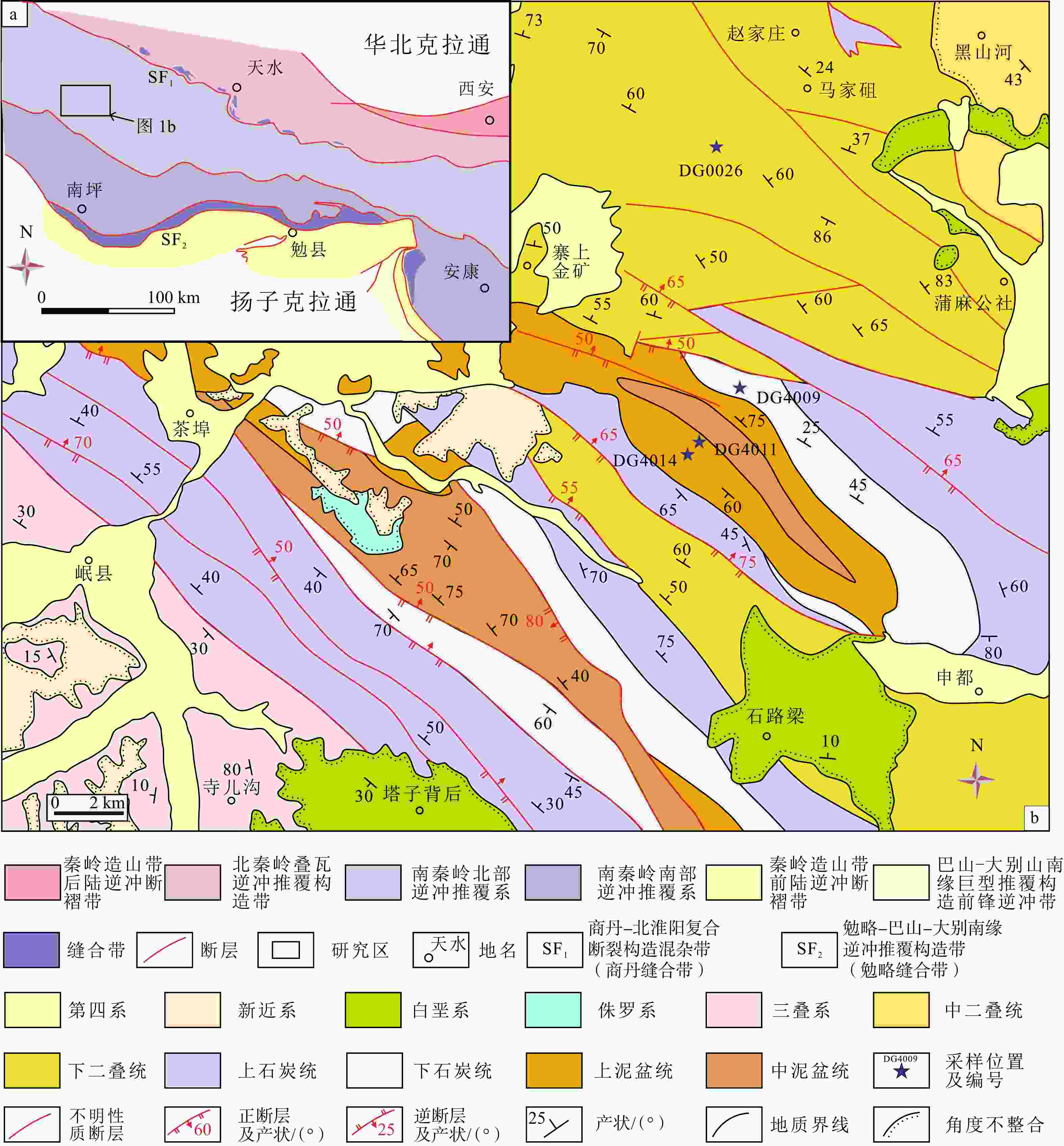
 下载:
下载:
